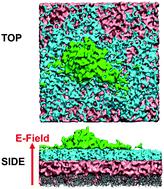当前位置:
X-MOL 学术
›
Phys. Chem. Chem. Phys.
›
论文详情
Our official English website, www.x-mol.net, welcomes your
feedback! (Note: you will need to create a separate account there.)
Formation and migration of H3O+ and OH− ions at the water/silica and water/vapor interfaces under the influence of a static electric field: a molecular dynamics study
Physical Chemistry Chemical Physics ( IF 2.9 ) Pub Date : 2020-10-01 , DOI: 10.1039/d0cp03656k Jesse Lentz 1, 2, 3 , Stephen H. Garofalini 1, 2, 3
Physical Chemistry Chemical Physics ( IF 2.9 ) Pub Date : 2020-10-01 , DOI: 10.1039/d0cp03656k Jesse Lentz 1, 2, 3 , Stephen H. Garofalini 1, 2, 3
Affiliation

|
The atomistic mechanisms of proton transport under the influence of a static electric field at various angles to the water/silica glass interface were simulated using a reactive, all-atom potential. The fields were shown to change the structure of the 20 Å water film significantly, as well as the concentrations and distributions of H3O+ and OH− ions in the film. The field was less than that needed for the dissociation of the water molecule, so the presence of these ions was caused by the interactions with the silica surface. While excess protons at certain silica surface sites can be highly unstable (rattling between adjacent surface sites), protons attached to surface sites that only sample other surface sites are shown to be less mobile in comparison to H3O+ and OH− ions in the water film. After creation of H3O+ and OH− at the silica surface, these ions were observed to have greater mobility away from the glass surface compared to near it. Fields parallel to the glass surface were shown to greatly enhance mobilities of OH− ions. Very high ion mobilities were observed at the water–vapor interface under field orientations of −45° and +45° (relative to the surface plane) respectively. These field orientations are able to pin charges to the vapor interface in addition to dragging them along it. Both vehicular and structural diffusion of the H3O+ and OH− ions were determined as a function of location in the water relative to the silica and vapor interfaces. The results indicate the importance of the orientation of a field to a glass surface and the water vapor interface on proton and ion transport in unsaturated pores.
中文翻译:

静电场在水/二氧化硅和水/蒸气界面上形成和迁移H3O +和OH-离子的分子动力学研究
使用反应性全原子电势模拟了在与水/硅玻璃界面不同角度的静电电场作用下质子传输的原子机理。字段显示出显著改变20的水膜的结构,以及浓度和H的分布3 ö +和OH -离子在膜中。电场小于水分子解离所需的电场,因此这些离子的存在是由于与二氧化硅表面的相互作用引起的。尽管某些二氧化硅表面位点上的过量质子可能非常不稳定(相邻表面位点之间的晃动),但与仅与其他表面位点采样的表面位点相连的质子却比H的移动性差3 Ò +和OH -离子的水膜。创作H的后3 ö +和OH -在二氧化硅表面,观察到这些离子相比靠近它具有更大的流动性从玻璃表面离开。平行于玻璃表面的字段均表现大大提高的OH迁移率-离子。在水汽界面处分别在-45°和+ 45°(相对于表面平面)的场取向下观察到非常高的离子迁移率。这些电场方向除了将电荷沿蒸气界面拖曳外,还可以将其固定在蒸气界面上。在H的两个车辆和结构扩散3 ö +和OH -根据水中相对于二氧化硅和蒸汽界面的位置确定离子。结果表明,电场对玻璃表面和水蒸气界面的取向对于不饱和孔中质子和离子传输的重要性。
更新日期:2020-10-16
中文翻译:

静电场在水/二氧化硅和水/蒸气界面上形成和迁移H3O +和OH-离子的分子动力学研究
使用反应性全原子电势模拟了在与水/硅玻璃界面不同角度的静电电场作用下质子传输的原子机理。字段显示出显著改变20的水膜的结构,以及浓度和H的分布3 ö +和OH -离子在膜中。电场小于水分子解离所需的电场,因此这些离子的存在是由于与二氧化硅表面的相互作用引起的。尽管某些二氧化硅表面位点上的过量质子可能非常不稳定(相邻表面位点之间的晃动),但与仅与其他表面位点采样的表面位点相连的质子却比H的移动性差3 Ò +和OH -离子的水膜。创作H的后3 ö +和OH -在二氧化硅表面,观察到这些离子相比靠近它具有更大的流动性从玻璃表面离开。平行于玻璃表面的字段均表现大大提高的OH迁移率-离子。在水汽界面处分别在-45°和+ 45°(相对于表面平面)的场取向下观察到非常高的离子迁移率。这些电场方向除了将电荷沿蒸气界面拖曳外,还可以将其固定在蒸气界面上。在H的两个车辆和结构扩散3 ö +和OH -根据水中相对于二氧化硅和蒸汽界面的位置确定离子。结果表明,电场对玻璃表面和水蒸气界面的取向对于不饱和孔中质子和离子传输的重要性。











































 京公网安备 11010802027423号
京公网安备 11010802027423号